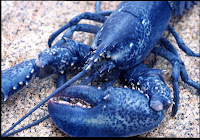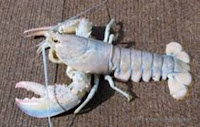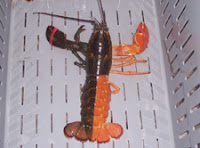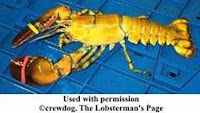Two-tone lobsters are rare, only about 1 in 50 million share this mutation. They would be wise to increase the frequency of this variation however as it inevitably saves the little guy from the pot. Lobster shells have three primary pigment colors, red, yellow and blue. Occasionally lobsters lack one or more of these colors and because the two sides of a lobster shell develop independently, startling two-tone specimens are possible. Their less fortunate plain-Jane family members turn red in the pot because the heat frees the red pigment molecules, uncoiling them from the dark protein chains that typically keep them under wraps.

Blue lobsters are more common than two-toned lobsters. Their frequency is about 1:1 million

White lobsters actually taste like coconut!
Two-tone lobster video







